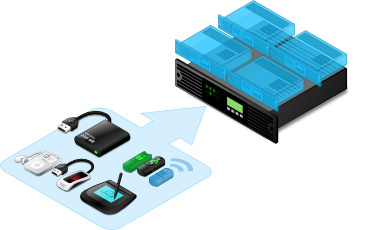

- #Usb redirector hyper v how to#
- #Usb redirector hyper v windows 10#
- #Usb redirector hyper v Offline#
The enhanced session mode allows you to access different device types inside the VM, such as printers and flash drives.
You need access to USB devices other than USB mass storage types. You need to share the USB device access with the host or multiple VMs. Linux VMs do not have enhanced mode support. Your guest VM’s operating system is Windows. Using the enhanced session mode is ideal when: With enhanced session mode, connecting to the VM using VMConnect allows you to use the host’s local devices and resources inside the VM. Removing the USB drive Enabling Client-Side Hyper-V USB Passthrough Access (Enhanced Session Mode)Īnother way to access USB devices in Hyper-V is through the client-side enhanced session mode. To do so, right-click Start and click Disk Management. To enable the server-side Hyper-V USB passthrough, follow the steps below.ġ. Consequently, removable drive types are not applicable for Hyper-V USB passthrough access. The Windows OS does not allow setting removable drive types offline, such as USB thumb drives or memory cards. #Usb redirector hyper v Offline#
For this reason, you’ll need to set the USB drive offline on the host first before you can enable it for Hyper-V USB passthrough access. The host and the VM cannot have simultaneous access to the USB drive.
#Usb redirector hyper v how to#
Related: How To Manage Hyper-V Host From A Non-Domain Windows Client Setting the USB Drive Offline on the Host
You want to control which USB storage devices are available to anyone who logs in to the Hyper-V VM. No other USB device types are compatible with server-side Hyper-V USB passthrough access. You only require access to non-removable USB mass storage devices. The Hyper-V VM guest OS is either Windows or Linux. This USB passthrough access method is appropriate if: In turn, the Hyper-V VM should have access to the USB device as if the device is directly connected to the VM. In a nutshell, the Server-Side Hyper-V USB passthrough means that you’ll be attaching a USB device to the Hyper-V host. Related: Getting Started Guide to Managing Hyper-V VMs with PowerShell Enabling Server-Side Hyper-V USB Passthrough Access This tutorial will be using an external USB hard drive and a USB flash drive. One or more USB storage devices that you’ve already attached to the computer. Also, this guide assumes that you’ve already started your VM. A Hyper-V virtual machine (VM) – The examples in this tutorial will be using a Windows Server 2016 VM named ATAWIN2016-1. #Usb redirector hyper v windows 10#
Hyper-V on Windows 10 or Windows Server 2016 and above – This article will use Hyper-V on Windows 10 version 21H1, and the host’s name is PH-5CG0022245. This article is a tutorial, and if you’d follow along with the examples, you’ll need to have the following. 
Enabling Client-Side Hyper-V USB Passthrough (Remote Desktop Protocol). Enabling Client-Side Hyper-V USB Passthrough Access (Enhanced Session Mode). Removing the USB Drive from the Virtual Machine. Adding the USB Drive to the Virtual Machine. Setting the USB Drive Offline on the Host. Enabling Server-Side Hyper-V USB Passthrough Access.






 0 kommentar(er)
0 kommentar(er)
